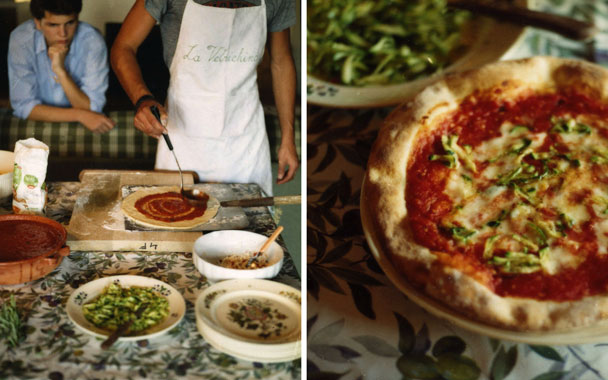We turned onto an unpaved road a few miles from San Casciano, a medieval Tuscan hill town south of Florence famous for its hot springs, and wound through a thick oak-and-chestnut forest, following the signs for our villa, La Vetrichina. Once we found it, Milvio and Marina Riccardi rushed out to the car to greet us: “Come state, belli?” Marina declared, clasping her hands together in a mixture of childlike and grandmotherly glee, pronouncing us “lovely” at the same time she was asking how we (total strangers) were doing. Then she shooed us into the kitchen.
A pair of heavy soup pots bubbled away on the stove. The tantalizing scent of sautéing onions filled the air, and, on the counter, a dozen tiny lamb chops sat marinating in a bowl of olive oil, rosemary, and sage. Marina lifted the lid of one of the pots. “Una bella zuppa,” she said, dipping a spoon into the porridgy liquid before handing it to my 15-year-old daughter, Michela. “Farro e ceci. Do you know chickpea-and-farro soup?” It might need salt, Marina warned. Of course it would get a drizzle of oil at the table, she assured us. A wicker basket on the marble counter bore jars of homemade apricot-and-plum jam, a loaf-shaped cake dusted with sugar, and a note wishing us a wonderful stay. We trundled off to find our rooms and to have a swim before returning to the kitchen to help Marina finish making dinner, a three-hour feast that tapered off into laughter and Vin Santo until almost midnight. Had we really just arrived?
There are people who seem blessed with an intuitive understanding of how the kitchen works, possessing a kind of gastronomic green thumb. I am not one of them. I was the six-year-old who, when baking her first cake, understood “grease the bottom of the pan” to mean the outside bottom. When asked to “watch the pot” while my mom ran out on some last-minute errand, I assumed my sole responsibility was to keep the thing from catching fire and burning down the house. I learned to cook the way an uncoordinated child learns to ride a bike: By falling, then getting up and trying again. This may explain why I would rather spend a day in the kitchen of a wonderful home cook than in that of a Michelin-starred chef. And why I am partial to Italy, where cooking is more a birthright than some onerously acquired skill. It certainly explains why my idea of a splendid holiday was a week in Tuscany with my husband, Jason, and our two kids in a villa owned by a simpatica host who had agreed to not only cook for us but with us.
We found our house through Homebase Abroad, a U.S. company that specializes in what it calls “the art of experiencing Italy.” Homebase can rent you a villa, as well as organize a fireworks display on the lawn or a few hours of hot-air ballooning. All we wanted to do was cook. As I perused its website, pulling up villa after villa on the screen, I kept returning to one particular selection: “Restored Tuscan farmhouse. Organic vegetable garden. Private cooking classes by charming English-speaking owners.” I imagined myself wandering through the garden, picking lettuce for lunch and, later, stopping by a farmers market with the owners. The charming owners. A straw basket would swing from my arm as I made joyfully spontaneous decisions about what we would cook for dinner. Before my fantasies could go any further, I had booked La Vetrichina.
Our house was a typical two-story Tuscan affair with thick whitewashed walls, high-beamed ceilings, terra-cotta floors, and a fireplace big enough to sit in. There was a rose-covered pergola and a terrace overlooking the valley, which was surrounded by a ragged string of mountains. There were more bedrooms than we had people to sleep in them, and a lot more space than we were used to inhabiting, but la cucina was no bigger than our kitchen at home. And yet, two things tipped me off that we were in the home of a serious Italian cook: The healthy assortment of sturdy metal espresso makers, the kind used for brewing on the stove, and the conspicuous lack of gadgetry—no food processor, no gleaming enamel mixer, no electric can opener.



 Pinterest
Pinterest






